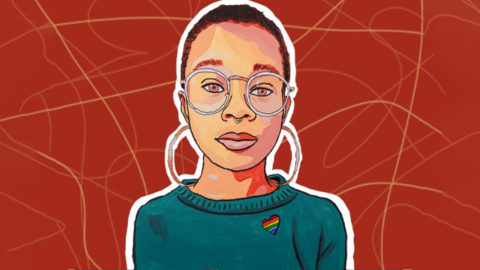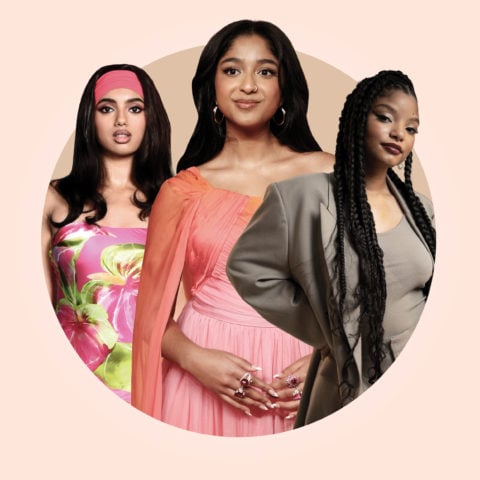To Be Young, Gifted, Black—and Lesbian
Writer Kinsey Clarke has always been immersed in Black history. But she still never saw herself represented

I read Octavia Butler’s celebrated Afro-futurist novel Kindred for the first time in my ninth grade English class, and I loved it immediately.
First published in 1979, Kindred is about a young Black woman, Dana, who lives with her white husband in 1976 Los Angeles. Until, that is, she finds herself repeatedly transported back in time to a slave plantation in antebellum Maryland, where she must save the life of Rufus, her (white) forefather. One recurring theme in the novel is the way your environment can encourage you to comply with social norms, even ones you might think you’re too smart, or politically aware, or strong to accept. Case in point: While Dana is in the past, she has to make difficult decisions in order to survive, including making sure that her great-grandmother, Hagar, is born—even though she knows that means Rufus has to rape Alice, Hagar’s mother.
It’s dark, but it’s still my favourite piece of literature ever, especially since it was the first time I’d seen a Black protagonist in science fiction. But perhaps more importantly, Kindred was my introduction to an author who was more like me than I could have imagined at the time. Thanks to that English class, I knew she was an only child, and I knew she’d died the year before I read Kindred, but that was it. So I was surprised—and secretly delighted—when a cursory Google search informed me that Butler was a lesbian. (Although she never discussed her sexuality publicly, there have been differing opinions on her sexuality. However, her contemporaries have confirmed that she was gay.)
By that time, I was in my junior year of college and just beginning to accept my own sexuality. I’d had a nagging feeling that I might be a lesbian since high school. But it took years for me to admit it, even to myself, because of my conservative Evangelical upbringing and the heterosexual expectations that came with it. In a way, I felt like Dana: completely in over my head in a world that could violently reject me, and struggling to reconcile what living truthfully in my identity would mean for me socially and personally, not to mention how it would affect my familial relationships.
That’s why learning about Butler’s orientation was so meaningful—during my search, I found out that she’d also grown up within the confines of strict Christianity and had managed to thrive despite it. And here I was, reading her most celebrated novel and connecting the dots from Butler and her characters to myself.
But even though I was elated to learn that I had something so important in common with my literary idol, I wondered why I hadn’t known about Butler’s identity when I first read Kindred. In fact, I started wondering why all the Black history I’d learned up to that point ignored LGBTQ people entirely.
And for the record, that was a lot of Black history. See, I was raised in Detroit—the Blackest city in the United States—and growing up I was surrounded by Black families, Black government and Black businesses. I attended Black churches and Black schools that had Black teachers who were more than willing to incorporate some kind of Black history into every lesson they taught.
But alongside stories about people like Rosa Parks and Ida B. Wells, I learned another lesson: that all our heroes are straight. It wasn’t until I did my own research, as I did with Butler, that I discovered many of the pioneering artists, activists, scholars, and authors I’d grown up learning about fell somewhere on the LGBTQ spectrum. In fact, the more research I did, the more I realized that these Black figures had been hiding in plain sight.
There was Ruth Ellis, the first Black woman in Detroit to own a printing company with her partner, Babe. Together, they provided refuge to gay youths in their own home. There was Barbara Jordan, the first Black congresswoman from the Deep South, who got shit done during the Watergate scandal and championed immigration reform in the 1990s. And there were Audre Lorde, Mabel Hampton, Angela Bowen, Pauli Murray, Ira Jeffries—all Black women who loved women like I do.
But few adults in my life were willing to talk to kids about the sexuality of our heroes. That Black gay people not only shaped history, but paved the way for a lot of their straight—and more famous—counterparts was withheld from me, and if my experience in one of the Blackest school districts in America was any indication, it was withheld from a lot of other Black children, too.
I didn’t know it at the time, but the erasure shaped my perspective of Black history: It was easy to come to the conclusion that Black LGBTQ people hadn’t made contributions to society.
Homophobia played a part, of course. Sometimes the rhetoric was violent and malicious, like Kevin Hart’s old tweets about how he’d break a dollhouse over his son’s head if he caught him playing with dolls. At home, at church, at the barbershop: being gay was something you hid out of fear of retaliation. But sometimes the homophobia was passive. Many Black adults considered being gay “grown folks’ business,” so it just wasn’t something they’d talk to kids about.
But whatever the motivation, I was left feeling that I wasn’t quite whole, and that’s another connection to Butler and her work. Kindred opens with Dana revealing without any explanation that she lost her left arm on her last trip home—it was crushed into a wall as she returned to the present. Butler later explained why she made that narrative choice in an interview, saying, “I couldn’t really let her come all the way back. I couldn’t let her return to what she was, I couldn’t let her come back whole and that, I think, really symbolizes her not coming back whole. Antebellum slavery didn’t leave people quite whole.”
I’m still trying to fill the spaces that childhood erasure has left in me, but Instagram has been my biggest tool. Accounts like the Black Lesbian Archives, Lesbian Representation, Butchcamp, and Lesbian Herstory Archives are a treasure trove of information about the love, work, activism and lives of women who lived before me, so that I could be who I am today.
Every time I learn about a new woman who broke boundaries in so many ways, I feel proud. But it also makes me wistful. Their narratives could have given me an entirely different perspective when I was growing up. I catch myself wondering how much sooner I could have stepped boldly into my identity as a lesbian if I’d had strong representation, and more teachers who hadn’t shied away from conversations about the ways same-sex orientation influenced some of our greatest icons.
But what I didn’t see growing up, I see now. There’s more Black lesbian representation in the mainstream for young girls growing up than I ever had in my youth, and we’re shaping the future by placing our lived experiences at the forefront: we’re love interests, mothers and superheroes. I see myself and others reflected in the words of Roxane Gay, the acting of Lena Waithe, the art of Mickalene Thomas, the swagger of Young M.A, the singing of Sydney Bennett, the craftsmanship of Jasika Nicole, the filmmaking of Be Steadwell and the photography of Zanele Muholi.
This isn’t to say that we’ve finally “made it,” because we haven’t. We still have a long way to go. But for the first time since I started paying attention, I’m seeing us centred and celebrated in stories, not relegated to the sidelines as a footnote. Black girls now have a head start. They have resources at their fingertips in ways that didn’t exist until recently—even if they aren’t being formally taught in school.
I think back to grade nine, when I read Kindred for the very first time, and I marvel at how much has changed in the world since then. The early teen version of myself had no idea that the book she was reading for class would change her life in just a few years’ time. Her environment hid the stories of LGBTQ people because they weren’t as palatable as the ones about hetero people, and teenage Kinsey accepted that because it was “normal.” But like Dana, I pulled through. That wasn’t going to be my reality.
And I’m ready to step into the shoes of the Black lesbian gamechangers who came before me.
This article was originally published on February 20, 2019.









